#Beth David Synagogue
Explore tagged Tumblr posts
Text
The Bible is true

View On WordPress
#Beth-S#Bible#Cana#Capernaum#Coins#Culture#Essenes#Events#Fishing boats#History#Jericho#Jerusalem#Jesus#Jonah#Judea#King David#Life#Listen#Mosaic#Qumran#Symbols#Synagogue
2 notes
·
View notes
Text

youtube
#post#nuclear#werewolf#from#outer#space#dipsomania#Psychonaut#personal#forest#tbilisi#with#water#garden#immortality#beth shalom#beit knesset#israel#synagogue#pray#david#rosh hashanah#zion#12 tribes of israel#cathedral#mitternachtsruf#Youtube
0 notes
Text
A Chabad synagogue in Pomona, New York, burned to the ground on April 17th, along with its three Torah scrolls.
Torah scrolls are hand-written, hand-made, and kept in elaborately decorated cases or wrappings.
Many of them have long histories; my synagogue has two, I think, that were smuggled out of villages being destroyed in pogroms or in Nazi attacks. One of them is the only remaining piece of that village on earth.
Sometimes, the Torah scroll doesn't even belong to the synagogue, but is on loan from a place like the Memorial Scrolls Trust:
There's an entire Jewish holiday just for taking them out and dancing with them: Simchat Torah, "The Joy of Torah."
In fact, that was the holiday on which Hamas's invasion took place.
instagram
So it's a particular tragedy when a Torah is destroyed.
Chabad itself has a page about what goes into making just one Torah scroll:
"An authentic Torah scroll is a mind-boggling masterpiece of labor and skill. Comprising between 62 and 84 sheets of parchment -- cured, tanned, scraped and prepared according to exacting Torah law specifications -- and containing exactly 304,805 letters, the resulting handwritten scroll takes many months to complete.
"An expert pious scribe carefully inks each letter with a feather quill, under the intricate calligraphic guidelines of Ktav Ashurit (Ashurite Script). The sheets of parchment are then sewn together with sinews to form one long scroll. While most Torah scrolls stand around two feet in height and weigh 20-25 pounds, some are huge and quite heavy, while others are doll-sized and lightweight."
I learned all of this on Tumblr.
Once upon time, in people's "punch Nazis" days, I would've been able to find some mention on Tumblr of this synagogue burning.
There is none, so I'm posting about it.
And I'm going to quote Daniel Weiner, Rabbi of Temple de Hirsch Sinai in Bellevue, Washington, when his own synagogue was vandalized last November:
"It’s horrific and heartbreaking.... [Taking out your feelings about] what's going on in the Middle East by defacing a sacred space of a synagogue -- that’s the very definition of antisemitism."
I'm also posting about the Kehillat Shaarei Torah Synagogue in Toronto, whose windows were broken on Friday, April 19th, by someone who also tried to break the front door down.
And the April 15 graffiti outside a Bangor, Maine synagogue that said, "Nazi Israel 30K murdered," next to a crossed-out Star of David. The same synagogue faced pro-Hamas flyers plastered around it in November.
I was going to include all the synagogues vandalized over the past six months. But there are way too many. Several every week. Lots are swastikas.
I'll go back to just doing attacks on and near synagogues.
Someone has to talk about the 1-year-old who was stabbed outside Temple Beth Zion-Beth Israel (BZBI) synagogue, in Philadelphia, on April 13th.
The foiled terrorist attack on a Moscow synagogue on April 11th.
The man who, on April 9th, screamed at the rabbi at Moldova's Great Synagogue, "What are you doing here? How come no one has finished you off for everything you are doing to the Palestinians?" Just one week after people had vandalized a Holocaust memorial in nearby Soroka, and sprayed "Free Palestine" on it.
The Oldenburg, Germany synagogue that was firebombed on April 5th.
The Florida Las Olas Chabad Jewish Center, which on March 16 burned, but not to the ground. The Torah scrolls were safe, and no one was hurt, but the back of the building was severely damaged.
The planned-but-thwarted-on-March-7th ISIS massacre in a Moscow synagogue.
The stabbing of an Orthodox Jew in Switzerland on March 5th. (He was badly injured, but expected to survive.)
A man leaving a synagogue in Paris was beaten on March 3rd.
People set the courtyard of a synagogue in Sfax, Tunisia on fire on February 27th. Firefighters managed to put the fire out before it consumed the inside of the building.
The synagogue is no longer used; there are no Jews left in its area, and fewer than 1,000 Jews left in Tunisia overall.
(Thousands of Tunisian Jews were sent to work camps during the Holocaust. Antisemitism across the Middle East continued to increase rapidly for decades. By the 1970s, 90% of Tunisian Jews had fled to France or Israel.)
On February 18, an Orthodox Jew leaving Synagogue of Inverrary-Chabad in Lauderhill, Florida, was beaten by an attacker yelling racial slurs.
Someone deliberately chose International Holocaust Remembrance Day, January 27, to smash all the windows in the front of Sgoolai Israel Synagogue in downtown Fredericton, New Brunswick.
On December 29, Turkey arrested 32 people linked to ISIS who were planning attacks on synagogues and churches.
On December 17, a man drove a U-Haul truck up onto the sidewalk between a barrier and the front door of the Kesher Israel Congregation in Washington D.C., got out, and started yelling "Gas the Jews." He also sprayed a foul-smelling substance on two people leaving the synagogue.
December 17 also saw 400 synagogues across the United States receive bomb threats.
On December 11, a man attacked an elderly couple on their way into a synagogue in Los Angeles, screaming, "Give me your earrings, Jew!!" and beating one of them bloody with a belt. (Happily, he chased the guy down the street, and caught him when his pants fell down.)
On December 10, a 16-year-old was arrested in Vienna for planning an attack on a synagogue.
On December 8, on the first night of Hanukkah, 15 synagogues in New York State received bomb threats. And someone screamed, "Free Palestine," and fired shots outside of Temple Israel in Albany, NY. Which has a preschool that was in session.
Meanwhile, the five Jews left in Egypt were canceling public Hanukkah candle-lighting at their synagogue out of fear of reprisals. Particularly after two Israelis in Alexandria had been gunned down by terrorists on October 8. (While Israel was still fighting Hamas in Israel.)
On November 15, a terrorist group set the only synagogue in Armenia on fire.
Armenian Secret Army for the Liberation of Armenia (ASALA) has a history of working with the Popular Front for the Liberation of Palestine (PFLP).
(PFLP is part of Hamas's network of groups. Samidoun is their nonprofit arm - which is why Germany banned Samidoun last year, although it's still active in many other countries.
PFLP is also actively supported by the Palestinian Youth Movement (PYM), a diaspora nonprofit group, and Within Our Lifetime (WOL), an SJP spinoff in NYC.)
On November 11, halfway through Shabbat services, police asked Central Shul in Melbourne, Australia to evacuate "as a precaution" due to a "pro-Palestinian" protest that had chosen the neighboring park as its gathering place. Australia has seen some very outspoken antisemitism at protests, including the march shortly after October 7 that chanted "Gas the Jews."
Also on November 11, protesters targeted a synagogue along a march route. They sat in their cars, spraying green smoke and shouting at people leaving the synagogue. The march itself featured a record number of horrifying signs and chants.
On November 7th, Congregation Beth Tikvah in Montreal was firebombed, and the back door of the Jewish organization across the street (Federation CJA) was set on fire.
On November 4, protesters chanted "Bomb Israel," and burned an Israeli flag outside the only synagogue in Malmo, Sweden.
During October, there were 501 antisemitic acts under investigation in France in just three weeks, including groups gathering in front of synagogues shouting threats, and graffiti such as the words “killing Jews is a duty” sprayed outside a stadium.
On October 18, people firebombed a synagogue in Berlin after homes all over the neighborhood were graffitied with stars of David.
And also on October 18, hundreds of "pro-Palestine" rioters attacked the Or Zaruah Synagogue, in the Spanish enclave of Melilla in North Africa, while worshippers were inside.
Based on the video, they seem to have blocked the synagogue entrance completely, while screaming "Murderous Israel" and waving Palestinian flags. (Melilla is an autonomous zone belonging to Spain. It borders Morocco.)
On October 17, during pro-Palestinian protests, hundreds of rioters set fire to Al Hammah synagogue, an abandoned house of prayer in central Tunisia. They hammered down the building’s walls and raised a Palestinian flag on the building. Police did not intervene.
The Facebook page "Tunigate", which has around 88 thousand followers, published a video of the assault. So did "Radio Bousalem”, with 83 thousand users. The vast majority of comments on these videos welcome these acts. The building was severely damaged and almost completely razed to the ground.
On October 15, bomb threats were sent to many East Coast synagogues. Attleboro synagogue Congregation Agudas-Achim received one of the emails, which read, "The bombs will blow up in a few hours. A lot of people will die. You all deserve to die."
On October 8 -- again, while Hamas was still in Israel -- Madrid’s main synagogue was defaced with graffiti that read “Free Palestine” next to a crossed-out Star of David.
And on October 7, an assailant in Rockland, NY fired a BB gun at two women entering a synagogue. Later in the month, a banner at the Stephen Wise Free Synagogue in the area was vandalized with the words, “Fuckin kikes."
#if you have used “Free Palestine” as if it's a sort of verbal assault you can shout in comments or scribble over flyers#if you are unwilling to hear what the Jewish term Zionism means to the people who use it#if you cannot name one Palestinian human rights activist#and most of all if you don't know how Hamas abuses Palestinians and you still think it's The Resistance#then you. are. the. problem.#if you don't know people in gaza have been protesting Hamas and blaming it for deliberately instigating a war they don't want#if you don't know how often they've spoken out about Hamas stealing aid and selling it to them#and especially if you don't want to believe me much less find Palestinians in Gaza to listen to#also if you didn't know about any of the stuff in this post BUT you have taken it upon yourself to tell Jews that “it's not antisemitism”#like seriously everyone deal with your learned distrust of Jews challenge#wall of words#fire tw#guns tw#violence tw#Instagram
786 notes
·
View notes
Text
It is, perhaps, no great surprise that the son of a talented cantor would grow up chanting prayers during Shabbat and holiday services. Or that Yair Keydar, 11, might perform Hebrew and Yiddish songs during concerts at various Jewish venues.
What could not have been anticipated, however, is that Keydar — known for his stirring renditions of “Oseh Shalom” and “Hashkiveinu” during services — would make his New York stage debut in an off-Broadway show called “Drag: The Musical.” The loud, fun, flashy production is about two rival drag queens who open competing clubs across the street from each other; the show opens and closes with voiceover messages from one of its producers, Liza Minnelli.
“It’s definitely super-different,” Keydar said, describing what it’s like to perform in what some might consider a risqué off-Broadway play after a lifetime in synagogues. “I mean, I’m dancing in a tutu in this show!”
Keydar’s somewhat unlikely journey into the world of musical theater began on the bimah. His Israeli-born parents met in the U.S., and a decade ago, his mother, Magda Fishman, became the cantor at Temple Beth El in Stamford, Connecticut. (His father, Zarin Keydar, is a global technical solution manager.) As soon as their young son could walk, he would run up to his mother during services and try to grab the microphone — a not-so-subtle foreshadowing of what was to come.
“The first time I remember singing in public, my mom did an interfaith event at a church, and wanted me to do a duet with her in front of about 500 people,” Keydar said in a recent interview.
Just how old was he at the time? “Three and a half,” he said.
In 2019, Fishman was hired by Rabbi David Steinhardt of the B’nai Torah Congregation in Boca Raton, the largest Conservative synagogue in South Florida. Steinhardt and I have been close friends since our Camp Ramah days in Palmer, Massachusetts in the 1960s. As a New Yorker who winters in Florida and often attends B’nai Torah, I was captivated by the cantor’s soaring vocals and vast, diverse repertoire of music.
At the same time, I began paying attention to the budding talent of her towheaded son. When the COVID-19 pandemic forced the suspension of in-person Shabbat services, I would watch Fishman and Keydar from their home on Zoom, singing their hearts out as if they were at Carnegie Hall.
It was clear something special going on with this prodigy, who was then just 7 years old.“In addition to his beautiful voice and sweetness, Yair has always been authentic, respectful, and kind,” Steinhardt said. “And he’s an extraordinary performer.”
After years of attending the Donna Klein Jewish Academy in Boca, Keydar added voice, acting and dance classes at the after-school Broadway Bound Academy. While originally focused on singing, “I started acting, and it just kept on going, and that’s when I realized I love it,” Keydar said.
In 2023, Fishman and Keydar came to Manhattan to perform in the National Yiddish Theatre Folksbiene’s “New York Sings Yiddish!,” a massive singalong in Central Park. The duo wowed the 4,000 in attendance that evening with what was possibly the most joyous version of “Chiribim, Chiribom” since it was first recorded by the legendary Cantor Moishe Oysher in 1931.
In May of this year, Keydar received rave reviews for his portrayal of Professor Harold Hill at the Broadway Bound Academy’s production of “The Music Man.” Having acquired a manager and agent in recent years, a life-changing phone call came in an unexpected location. “I was shopping with my dad at Walmart, and both my manager and agent wanted to talk with us,” Keydar said. “We went to the back of the store where they were restocking things, and they told me I had booked the role of Brendan in ‘Drag: The Musical.’ I wanted to scream it to everybody! It was such a surreal moment.”
It was also a vindication of Keydar’s commitment to performing. For years, he said, many of his schoolmates “didn’t get it.”
“Especially me as a boy doing dance in school instead of P.E., I’m not going to say I was bullied, but I got teased for it,” he said. “And I just feel like, I don’t bully people for playing football and soccer; you have your thing, and I like singing, dancing and acting. But my close friends, they get it.”
After several weeks of previews, “Drag” opened in October. Keydar alternates in the role of Brendan — a 10-year-old who finds himself drawn to the sparkly sunglasses and glittery outfits of the drag queens — with another young Jewish actor, Remi Tuckman.
In addition to fulfilling his theater dreams, Keydar is also excited about living, with his father, in Manhattan. “I love New York,” the newly minted Hell’s Kitchen resident, who is continuing his studies at a Florida virtual school, said. “It’s so much fun. It’s my first experience with city life.”
Keydar said that his “Drag” character resonates deeply with him. “It’s a powerful character, and it relates to me in many ways,” he said. “I think it encourages other kids to be who they are.”
Audiences and reviewers are loving the campy show, and Keydar has received extravagant praise. “Keydar sings like an angel,” Chip Deffaa of TheaterScene.net wrote. “He has only two numbers. But no one in the show earned greater applause than this young boy, now making his New York stage debut. Just a beautiful, unspoiled — and sweetly tender — performance. No attitude. No guile. Just singing from the heart.”
Rave reviews are wonderful — but what matters more to Keydar is the feedback from the well-known actors who are his co-stars. Brendan’s conservative, uptight dad is portrayed by Joey McIntyre, the actor/singer/songwriter who gained instant fame at age 12 when he joined the late-1980s boy band New Kids on the Block. “He’s lovely,” McIntyre, the father of three teenagers, told me about Keydar. “And I’m not just saying that. He’s incredibly talented and really funny. I admire his work ethic, and his joy for what he does. I’m very happy for him.”
Actor/singer/dancer Nick Adams, a Broadway mainstay since 2007, dazzles in the role of drag queen Alexis Gillmore, who is also Brendan’s uncle. “I see a lot of myself in him, especially in this role,” Adams said of Keydar. “Just wanting to perform at that age, and to explore theater. I’m very surprised at his presence on stage; he’s really in the moment with me. It’s a gift to work with him, I’m very thankful we have him, and I don’t want him to get too old!”
Acclaim is coming from all corners. In honor of the hit movie “Wicked,” Keydar recorded a cover of a song from the musical, “The Wizard and I,” written by composer and lyricist Stephen Schwartz (who also wrote the music for “Godspell,” “Pippin,” “Prince of Egypt” among others).
I thought that Schwartz might enjoy seeing how Keydar performed the song, so I sent him the YouTube link. The multiple Grammy, Oscar and Golden Globe winner loved the boy’s rendition, writing: “Yair is an extraordinary young talent with a beautiful voice, and a remarkably mature knowledge of how to use it.”
Back in Boca — where Keydar’s mom continues to work as a cantor — Steinhardt said that most B’nai Torah members are ecstatic over Keydar’s success, and at least two dozen have come to New York to see the show and kvell. “Our congregation is very proud of him,” he said. “His endearing personality has made him feel like the young son of so many people in our community.”
As for Keydar, he’s clear about his future. “This is my dream,” he said. “This is what I’ve been working towards. I can’t wait to continue and do more and see what’s next.”
“Drag: The Musical” has an open-ended run at Manhattan’s New World Stages (340 West 50th St.). Yair Keydar is currently scheduled to perform in the show until the end of March.
9 notes
·
View notes
Text
Published: Dec 23, 2024
Something is rotten in Canada, not just the crumbling coalition government.
Some 400,000 Jews – the fourth-largest Jewish population center in the world after Israel, the US, and France – live in the beautiful, spacious country that takes pride in its heritage of tolerance and pluralism.
Now, this population is under attack. B’nai Brith Canada (BBC) saw a record high of 5,791 antisemitic incidents in 2023, a 109% increase from years prior.
Shimon Koffler Fogel, the outgoing CEO of the Centre for Israel and Jewish Affairs (CIJA), the leading Canadian Jewish community advocacy agency, recently gave testimony before the Canadian Senate’s Standing Committee on Justice and Human Rights.
As Post columnist David Weinberg wrote on Friday, Fogel told the committee that since Hamas’s October 7 massacre and Israel’s retaliation in Gaza, there has been a 93% rise in hate crimes in Toronto, nearly half of them directed at the Jewish community.
In Vancouver, reports of antisemitism increased by 62% in 2023 over 2022, marking a 70% rise after October 7. In Montreal, antisemitic incidents rose by 250%.
As for Toronto, shots have been fired on three different occasions at Bais Chaya, a Jewish girls’ school, with the most recent incident occurring on Friday night.
In Montreal, assailants last week firebombed Congregation Beth Tikvah, a modern Orthodox synagogue in the Montreal suburb of Dollard-des-Ormeaux, for the second time in just over a year.“This is a terrifying reminder that Montreal is increasingly unsafe for Jewish people,” the synagogue’s cantor, Henry Topas, said in a statement.
An accountability failure
“This is the result of the failure of leaders at all levels to hold accountable those responsible for the hate and violence that is infesting Canadian society,” Topas, who is also the BBC’s regional director for Québec and Atlantic Canada, added.
“In a matter of months, Canada has become a country in which masked thugs took over our streets to burn Canadian flags, salute Hitler, celebrate terrorists, and call for violence,” said Richard Marceau, the vice president of external affairs and general counsel at the CIJA.
The efforts to combat the rising tide of antisemitism in Canada weren’t helped at the weekend by the exchange of statements between Diaspora Affairs and Combating Antisemitism Minister Amichai Chikli and Canadian Liberal Party MP Anthony Housefather, Prime Minister Justin Trudeau’s Jewish community adviser.
In a post on X/Twitter, Chikli claimed that Canada was no longer safe for Jews. Responding to Chikli, Housefather said that his comments were “false and exaggerated” and that Canada was one of the best places in the world for Jews to live in despite the rise in antisemitism.
What is the truth?
The truth is probably somewhere in between.
Trudeau said he was “sickened by reports of shots fired at a Jewish elementary school in North York.” He called it “a hateful, antisemitic attack.”
Trudeau issued a similar statement last week after the Montreal attack, but many Jews in Canada say that his government’s desire not to provoke the country’s large Muslim population has muted any concrete response.
Additionally, they say that Canada’s lukewarm support of Israel post-October 7 (Trudeau is one of the few Western leaders who did not pay a solidarity visit to Israel) has emboldened the anti-Jewish sense of empowerment.
On Friday, however, the Canadian government announced that it has created a National Forum on Combating Antisemitism, which will be held in Ottawa in February 2025.
“The Government of Canada recognizes the urgent need for national leadership to ensure Jewish Canadians feel safe in their synagogues, schools, and communities,” a statement read.
Deborah Lyons, Canada’s special envoy on preserving Holocaust remembrance and combating antisemitism, welcomed the forum, saying, “Jews are the number one target of reported hate crimes in Canada despite making up just over 1% of the population. Antisemitism shouldn’t be a partisan issue.”
How Canada responds and deals with the scourge of antisemitism will have far-reaching implications for Jews in the rest of the Diaspora. If Jews aren’t safe in Canada, they won’t be safe anywhere.
Let’s hope that the platitudes of protecting the Jewish community will translate into concrete action that demonstrates there will be zero tolerance for targeting anyone solely because they’re Jewish.
--

#Canada#antisemitism#terrorism supporters#islamic terrorism#islamic violence#islam#religion is a mental illness
3 notes
·
View notes
Text
AUSTIN, Texas - A federal judge handed down a sentence for the man who set an Austin synagogue on fire two years ago.
Members of Congregation Beth Israel looked on as Franklin Sechriest was sentenced to 10 years for setting fire to their synagogue on Halloween 2021. Sechriest pleaded guilty to federal arson and hate crime charges in April.
"The staff, as well as members of the congregation, have been living with this for two years. And we're still living with it because the sanctuary is still not usable. There's still yellow tape across the doors and the doors are still burned," said Senior Rabbi Steven Folberg. "But I think that for myself and for some of us, there is a sense of relief that we can move forward, that this piece of this is done, and that we don't have to keep revisiting it and revisiting it in the same way that we have."
In the courtroom, Sechriest could be seen throughout the morning looking back at his parents and mouthing, "I’m sorry."
He apologized to the court as well, saying, "I will never forgive myself." He also promised to continue to "atone" for his actions and denounce the "evil ideology."
According to his defense attorney, that ideology was the result of indoctrination by online hate groups that Sechriest had stumbled upon while seeking community during COVID.
His defense attorney also asked for leniency due to Secriest’s diagnosed medical issues, which include Autism and OCD.
"I don't think that any of those issues had anything to do with what he did," said Assistant U.S. Attorney Matthew Devlin after the sentencing. "He made voluntary choices. He made intelligent choices on his end, and he engaged in a lot of premeditation, a lot of planning, and it was very deliberate."
The judge ultimately agreed though he expressed empathy toward those struggling with mental health and their parents.
"There is nothing more that you could have done," said Judge David Ezra, addressing Sechriest's parents. "It wasn’t your fault."
However, Judge Ezra said the biggest factor in his decision was the danger he felt Sechriest could be to others going forward.
"We applaud the decision to sentence the Congregation Beth Israel arsonist to 10 years in prison," said Jackie Nirenberg, regional director for ADL Austin, in a statement shared with FOX 7. "We are grateful to the FBI San Antonio office and the Austin Fire Department for their thorough investigation into the incident, and the prosecutors from the US Attorney's Western District of Texas office for sending a message that hate and antisemitism will not be tolerated in our community."
Sechriest is not eligible for parole and will have three years of supervised release after he completes his sentence. The judge is also going to recommend that Sechriest be committed to a federal medical facility.
12 notes
·
View notes
Text
The Nessah Cultural and Educational Center

A prominent and career businessman, David Raminfrad is the president of Kaslen Textiles and New Point Fabrics. Both companies import and supply drapery and upholstery to high-end designers, furniture manufacturers, and upholstery dealers. David Raminfrad is also involved in community initiatives. He is a member of Nessah Cultural and Educational Center, attending board meetings and supporting their cause.
Founded in 1980 by Rabbi David Shofet and the Iranian Jews of Beverly Hills and Los Angeles, the Nessah Cultural and Educational Center aims to preserve the tradition and customs of the Iranian Jews as per the Orthodox, Sephardic Halacha. The halacha is a distilled, clearer, and shorter version of the early-age publications of Jewish laws, codes, and scripts. The center offers a dedicated location for the Iranian Jewish community to pray, celebrate the holy days and festivities, network, participate in social and educational programs, and study the Torah, the Hebrew holy book.
The Nessah Synagogue idea started from the nine men who showed up at the first prayer session, in a co-shared space with another orthodox conjugation, at Beth Jacobs. The numbers grew, thus necessitating a bigger space. Mr. Shofet, with the support of the newly formed Iranian Jewish Community in Los Angeles, worked on establishing an established and regular congregation and a board of directors and trustees.
The new team implored the idea that education was the feasible way to promote Iranian Jewish culture and customs, especially for the young Los Angeles-based congregation. After several relocations, they established the Nessah Educational and Cultural Center. It offers weekly Torah classes, lectures, daily prayers, counseling, and other programs like the Nessah Youth. Open to children between five and 12 years, Nessah Youth offers programs specially designed to instill Jewish culture at an early age. The program includes prayers and learning, an introduction to cultural foods, games, and traditional events.
0 notes
Photo

Recipe Collection of the Sisterhood of Beth David Synagogue, 1960
2 notes
·
View notes
Photo

David Hartt at Beth Sholom Synagogue
77 notes
·
View notes
Photo



Beth David B'nai Israel Beth Am Synagogue, Toronto, Irving Grossman, 1959
179 notes
·
View notes
Text

Old man and a young boy in the Beth Yaakov synagogue in Kuzguncuk, Istanbul, Turkey, 1984
The neighborhood of Kuzguncuk is sacred for Turkish Jews, as for over five centuries its Jewish cemetery on Nakkaştepe has been the resting place of buried pilgrims from all over the world who once dreamed of going to Jerusalem but never reached their destination. The Stars of David decorating the synagogue are visible from the main thoroughfare where the neighborhood meets the Bosporus. Its inner sanctuary features a beautiful mural said to have been drawn by a Persian calligrapher. Referring to the historic multicultural character of the neighborhood, there is a quintessential Kuzguncuk saying "after an Armenian dinner, meet a Greek woman in a Jewish home". It was told to Turkish architect and poet Cengiz Bektaş in 1991 by an old resident.
61 notes
·
View notes
Text
Он пел в бобруйской синагоге (звукозапись начала ХХ века)
Сегодня вы не только узнаете о том, кто такой Арье Лейб Рутман, начинавший свой путь духовного служения в Бобруйске, но и услышите голос великого хазана из далекого 1914 года.
Мы рождены для вдохновенья, Для звуков сладких и молитв.
А. С. Пушкин.
До первой половины ХХ века в странах Восточной Европы блистало целое созвездие замечательных вокалистов-канторов. Это были обладатели голосов редкостной красоты, виртуозно владевшие музыкальным даром.
Религиозная традиция иудаизма вкл��чает, помимо пения молитв и псалмов самими верующими, сольное исполнение литургии духовным певцом, кантором. На иврите такой певец называется «хазан». Само слово хазан происходит от корня «хаза», смотреть. Так в древние времена называли смотрителей Иерусалимского Храма, помощников первосвященников. Позже в европейских странах за ними укоренилось название «канторов» (от лат. cantor — певец). Начиная с 7-го века искусство хазанута передавалось по наследству, а браки заключались в собственной среде.
С вокальным искусством канторов сталкивался обычно лишь ограниченный круг слушателей — посетителей синагог, однако эти духовные песнопения можно отнести к шедеврам музыкального искусства. С появлением граммофонной записи стало возможным увековечить голоса знаменитых канторов начала ХХ века.
Евреи всегда высоко ценили вокальное искусство. Говорили даже, что хороший человек, который прекрасно поет, может исправить мир. Но, чтобы стать настоящим кантором, мало было обладать прекрасным голосом. В хазаны выбирались наиболее праведные люди. Некоторые из них являлись одновременно учителями, раввинами и чтецами Торы.
Арье Лейб Рутман родился в 1866 году в местечке Жлобин. Его учителями были выдающиеся канторы Борух-Давид Кершер, Йоэль-Зейлиг Минскер и Ноах Лидер, у которых маленький мальчик был солистом хора. А свой первый пост кантора Арье Лейб получил в Бобруйске. Именно здесь зазвучал во всю силу голос его молитв, которые достигали самих небес.
Позже Арье Лейб служил в Слониме, Одессе, Кременчуге, где, по преданиями, для него была построено новое большое здание синагоги. Затем последовало назначение кантором Санкт-Петербургской Хоральной синагоги и, наконец, Рутмана пригласили на работу в Варшаву. Одновременно последовало и предложение от фирмы Zonophone о записи серии грампластинок.
Zonophone (ранее также обозначавшаяся как Zon-O-Phone) — звукозаписывающая компания, основанная в 1899 году в Камдене, штат Нью-Джерси. Позже название было приобретено Columbia Records, Victor Talking Machine Company и, наконец, Gramophone Company / EMI Records.
В 1913 году Арье Лейб Рутман приезжает в Соединенные Штаты для записи пластинки и остается здесь из-за разразившейся Первой Мировой войны. В 1914 году выходит пластинкa с двумя произведениями в исполнении Рутмана: «Ki Lekach Tov» и «V’Shomru».
Арье Лейб Рутман стал первым европейским кантором, осуществившим запись для Zon-O-Phone.
В США Арье Лейб Рутман служил кантором Кегилат Йешурун в Нью-Йорке, а затем в Детройте, в бостонской «Хадерет Исраэль» и Толедо, штат Огайо.
В памяти современников Рутман остался «Кантором канторов» и основателем собственной канторской школы, выпускников которой называли «рутманистами».
Арье Лейб Рутман (Aryeh Leib Rutman) скончался в Нью-Йорке в 1935 году. Похоронен на кладбище Beth David, в Квинсе.
https://bobruisk.guru/he-sang-in-the-bobruisk-synagogue/
1 note
·
View note
Link
I remember the first Dyke March, organized by the Lesbian Avengers in 1993 during the LGBT March on Washington. I was there, and I remember feeling that I was finally free — that we dykes could claim all of who we were — our full and complex identities, our bodies, our love, our commitments to equality and justice for all — and be utterly unashamed. It, and the subsequent marches since all over the country, have been profoundly liberating for so many people.
This month, the Dyke March is coming back to Washington, DC, after a 12 year hiatus. It’s claiming its grassroots feel and justice roots, standing with the oppressed and the displaced, and it should. But the DC Dyke March has decided to ban Jewish stars on flags, and that’s a big mistake.
First of all, as Rabbi Danya Ruttenberg demonstrates in these tweets, the Magen David has a history as a Jewish symbol that stretches back at least 1,700 years. Our people have claimed the Jewish star as a sign of pride and identity, and it also has been used against us for purposes of oppression and annihilation.
Banning Jewish stars on flags is not just anti-Zionist but anti-Semitic. Let’s not forget that we are living in a time of perilous anti-Semitism, in which two synagogues were subject to murderous anti-Semitic attacks. In Brooklyn, where I serve as a rabbi to a large congregation, we are in the midst of an epidemic of random and unprovoked assaults on Orthodox Jews by seemingly unrelated people of diverse backgrounds. Anti-Semitic violence only becomes possible in a climate of normalized anti-Semitism. This decision contributes to that climate.
But that’s not the only problem. A deeper, bigger, and more complicated problem is an overly-simplistic and misguided approach on the Left when it comes to Israel/Palestine. There’s an urge towards purity on the Left, a desire to split the world into good guys and bad guys. I know, I come from the Left.
The problem is, the real world is not that neat or simple. And in the case of Israel/Palestine, both peoples need self-determination, freedom, and safety. Both peoples have a valid claim to and history in the land. Both peoples have a history of trauma.
Choosing Palestinians over Israelis, seeing the humanity and narrative of only Palestinians adds to the conflict and delays a time when both peoples can live with self-determination, freedom, and safety. As Palestinian and Israeli leaders in groups like the Bereaved Parents Circle and Combatants for Peace say time and again, “If you are pro-Israel and anti-Palestine, or pro-Palestine and anti-Israel, you are not helping. We need people who are pro-Israel and Pro-Palestine, pro-Palestinian and pro-Israeli. That is the only way you can help.”
Sometimes people oppose Israel’s right to exist by saying that they are against nationalism. But you can’t be against nationalism when it comes to the Jewish people and in favor of nationalism when it comes to the Palestinian people. In this line of thinking, DC Dyke March organizers say that they’ve banned the Jewish star on flags because it’s a nationalist symbol, but that they welcome the Palestinian flag. They say that they stand with the Palestinians because they are a displaced people. A cursory study of Jewish history would demonstrate that the Jewish people have been displaced over and over again, all around the world.
Let me be clear: Israel is abusing its power. Israel’s policies violate the human rights of Palestinians and threaten the future of the Jewish people, and must change. The occupation of the West Bank must end. There are many Israelis working every day to bring about that change. I just brought 32 people from my congregation to visit Israel and the West Bank, and we met amazing activists on the ground who are dedicated to a just, safe future for both peoples, groups like Breaking the Silence, the New Israel Fund, and so many more.
We Americans can relate to their struggle, as we work every day in this country to change the unconscionable policies and behaviors of our government. Israel is not a theory, and it is not monolithic. It is a real country, with people who disagree with the government and are struggling for a better life and future.
Dykes, we know what it is to hold complexity. Let’s stretch ourselves to embrace this complexity. Let’s be both pro-Palestinian and pro-Israeli.
Rabbi Rachel Timoner is a renowned rabbi, author and activist. She currently serves as Senior Rabbi at Congregation Beth Elohim in Brooklyn, New York and previously served as Associate Rabbi of Leo Baeck Temple in Los Angeles, California.
#dyke march#dykemarch#jewish women#jewishwomen#rabbi danya ruttenberg#israel#antizionism#rabbi rachel timoner#rabbi timoner#rachel timoner#rabbi ruttenberg#palestine#nationalism#zion#tzion#zionism#pro israel#pro-israel#judaism#jewish
84 notes
·
View notes
Text
FTWD 5x12: Ner Tamid - Analysis
Wow! This episode had so much in it! You know how sometimes I don't go over the minute details in the background because I feel like you guys already know them and they only serve to illustrate parallel? This was kind of the opposite. I will talk about the major parallels I saw, but the amount of small details was mind blowing and I think they're important.
***As always, spoilers abound for episode 5x12 below. Don't read until you’ve watched.***
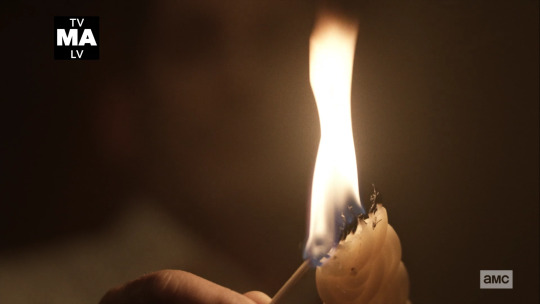
We start with the image of the fire burning. It's a rope that's being lit by a match. We also see a chalice that has a Star of David on it. This is a rabbi in a mosque who is observing some Jewish worship. The first thing this reminded me of is the altar that Morgan built in Coda.
Of course, the rabbi’s sermon gets interrupted by walkers. I thought it was interesting that he put on a jacket. After all, it didn't look particularly cold outside.

They had him stop and put on a black jacket for no apparent reason. He was wearing a black jacket over a white shirt, so suddenly he was wearing black and white.
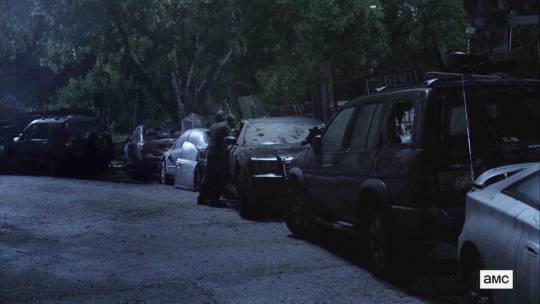
While outside, he sees a car with three walkers trying to get into it. My first thought was that there must be someone in it, and there was. He took down the first two walkers without too much trouble, but the third one ended up on top of him. Then the car door opens and Charlie steps out.

Okay, so many interesting clues in this sequence. We have the altar from Coda, the Star of David, the black and white colors, and the fact that there's a girl alive in the back of the car with walkers surrounding her.
Naturally, my first thought was that maybe Charlie is meant to be a proxy for Beth here. I think she is, and I've wondered before if maybe she's meant to be. There hasn't been anything super huge pointing to her being a Beth proxy thus far, but remember that she shot Nick. And it's not like Beth shot any main characters before she disappeared or anything, but even so, I thought there might be something to that. Ever since Charlie appeared, she's been sort of a background character. She's always around but they haven't spent a lot of time on her characterization. I thought maybe they were holding her in reserve for something. Given her role in this episode, she's definitely starting to look like a proxy.
The rabbi introduces himself Rabbi Jacob Kessner and says the mosque is called Temple B’nai Israel. Charlie says she saw the light in his church, and that's what drew her toward him. He tells her it's not a light. It's Ner Tamid (title of episode). It's the flame of truth or of God and God lead her to him. Then, it looks like the light is flickering and about to go out and he says that flame of truth needs new batteries.

Holy TD symbolism, Batman! First of all, Battery Theory. And there's a big emphasis on batteries throughout this episode. Of course, all that started at Grady because we saw so many batteries that were dying. Also remember that Norman said that Beth was Daryl's light in the darkness and to see that light go out was very sad. Now, in this episode, we have an emphasis on a perpetually burning light that's never supposed to go out. Sounds like a Beth parallel to me.

Another interesting detail: the rabbi keeps referring to God as a “she.” At first, I thought maybe he was referring to the flame as a “she.” And maybe he was. But he did it more than once. I can tell you that’s a little weird. A very traditional Jewish rabbi, as this guy seems to have been, would not think of God as a woman. The god of the Old Testament, whom they worship, is and was always male. So why would he do this? Whether he’s meant to be referring to God or the flame, it feels like a hint from the writers about who the flame or Christ figure in the show is, you know?
Back with Sarah, Dwight, and the rest of the group, we see the armored truck roll over a walker’s head.
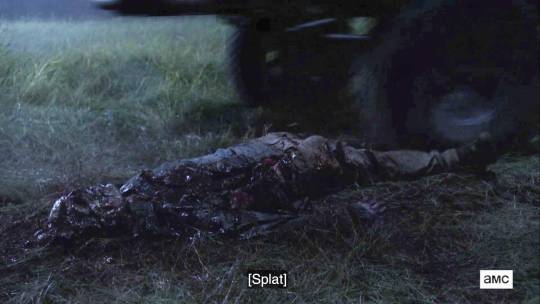
After that, the rest of the cars in the convoy also went over the walker and smash it to bits. It just reminded me of Consumed. When Daryl and Carol were following the cop car into Atlanta to look for Beth, we very obviously saw them smash a walker head in the same way.
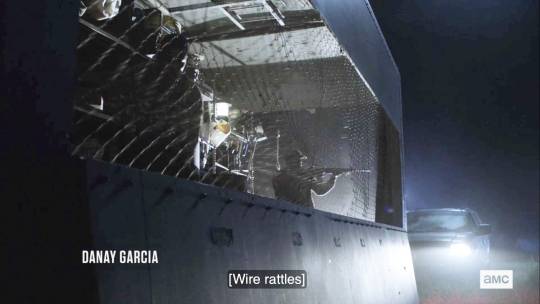
When the convoy stops to set up camp, they use rolls of chain-link to guard against walkers. It just reminded me of the prison. We also saw Charlie and the rabbi killing walkers on the fence around his synagogue. So lots of callbacks to the prison.

When the caravan stops to rest, they us a circular setup for their camp with the tanker in the center. It's a smart way to set up camp against walkers and other enemies, but the circle is also interesting. A couple of things I think this could be.
We’ve talked before about how Morgan’s symbol of the X inside the circle, which we saw in Coda, could possibly be a lamp sign or the symbol for the positive charge of the battery, which is also often symbolized by an X or cross inside a circle. This looks at the negative charge the battery. The minus sign inside a circle. And given that there's a big emphasis on batteries here, I think that's interesting. I may be developing more of a theory about this, but I'll leave it for another time.
Charlie refers to the Light of Truth a lamp once or twice. Which, to be fair, it is. It’s not an actual flame, but rather a light, which can be plugged into a batter, in the shape of a flame. So it works in a literal sense. But also, Lamp Theory.
The other thing I couldn't help but think of is that when we first met the hipsters (Jadis’s people), they encircled Rick's group and we got a bird’s eye shot of them in a circle. I think this is probably part of that same symbolism.
We heard a few 8s in this episode. When talking about going to get gas, Sarah said it would be “tank town at 0800,” which was her way of saying they were going to get gas at eight. Of course they didn't, because they realized Charlie was missing.
Then the rabbi said it took him eight years at Yeshiva to understand what Charlie had already figured out. I looked it up and Yeshiva is a Jewish university. I’m really side-eyeing that. He’s referencing 8 years of education. Remember that there was an 8 beside Beth in Tyreese’s death hallucination and now we’re 8 years post-Coda.
The Rabbi was talking about how God had led her to him and he said, "maybe there's something you need here." So, more of the “something you need” theme.

It occurred to me that the inside of the synagogue looked a little bit like Ezekiel's theater in the kingdom. Because it’s q synagogue with pews, it also naturally looks a little bit like Father Gabriel's church. And of course there’s the church Glenn and Enid went into in 6a.
The rabbi also explained the resurrection in a way that had a very strong parallel to what Herschel told Rick in S2. While on the highway in the finale, waiting for the others to find them, Herschel said he'd always believed in the resurrection of the dead, but what was going on with the walkers wasn't exactly what he had in mind. The rabbi said something very similar. That he used to tell his congregation that eventually the dead would reunite with their bodies and be resurrected, but he thought he only got it halfway right. So, a major call back to Herschel and S2.
He also said tradition was very important. This is definitely true from what I understand of Jewish culture. They're very ardent about their traditions. I also took it to perhaps be a line the writers might be aiming toward us and the symbolism in general. As if to say that precedent in the show is very important.

We had more emphasis on the battery because he was on his last battery and it started to go out. In order to keep the lights going, he needed to find new batteries. Definitely feels like a theme to me. Obviously, the light equals hope and you need batteries, apparently, to keep that hope burning. These are all things we saw heavily around Beth and Grady.

The rabbi goes to another building and finds that it's full of walkers, who are escaping. My first thought upon seeing building is that it looked like a lot like the school from S5. The same school the Termites camped out in front of. Many of Father Gabriel's congregation (as walkers) were in it, which is why he broke out of his church in Coda and went there. It was in that scene that we saw him look at a bible and one of the pages said Bethel on it.
So this rabbi definitely has heavy parallels to Father Gabriel in S5. He is alone in his synagogue and his congregation is dead. They been imprisoned in a building some distance away from his church.
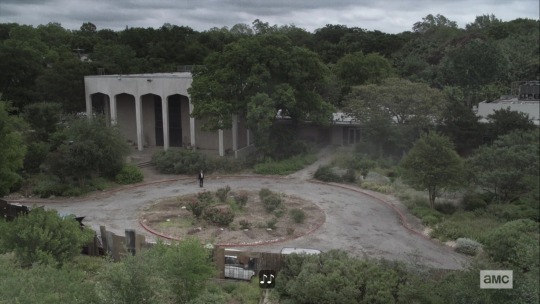
When he goes looking for them, there's a circular driveway in front of the building. So that circle theme appears again. We also see red flowers. I'm thinking the red flowers, just like the color red, equals death. I was reminded of the poem, In Flanders Fields, which is a famous poem about red poppies growing where men in war died. Just goes to show that his congregation was dead, even though they hadn't revealed that to us yet in the show.
Upon seeing this, my first question was whether the rabbi locked his congregation in there, just as Gabriel locked his congregation out. We don’t find out what happened until about three quarters of the way through the episode. This rabbi didn't have as much culpability as FG did. He didn't actively sentence his congregation to death. We do find out that he was having a crisis of faith — much like FG in S5 — and that he abandoned his flock to go try and figure out his own psychological crisis.
When he returned, they’d been locked in that building already. So, he abandoned them and then they died. But he did not orchestrate their deaths in quite the same way FG did with his flock. Still, the parallels are there.
I think this is important is because 1) We saw this around FG in S5 while Grady was happening. So even though Beth never met FG, it was definitely happening around her storyline. And 2) FG is now a walking embodiment of Sirius symbolism.

John and June come to pick up Charlie and the bring a battery for the rabbi. They emphasized the number 36 by having June say there were 36 people in the convoy. The rabbi then said that some people believe there were 36 righteous people in the world at any given time. There are a few ways you could read this. 6x03 is Glenn’s death fake out episode. 3x06 doesn’t especially stand out to me. Series number 36 was 4x01. You know, where Beth came front and center?

Meanwhile, back at camp, Sarah and Dwight sit atop a trailer, keeping watch together and drinking beer. Dwight says the beer is pretty good, and Sarah says, "Seriously?" There’s the Sirius reference for this episode. Pretty much every episode of this season has had one.
The two of them have a casual conversation, but I found it kind of interesting. Sarah asked Dwight how long he'd been on his own, and he didn’t know. He said he lost track of time. So, he doesn't even know how long he's been gone from DC. Interesting, as they’re kind of playing with time again. Then Sarah says, "but your gal kept going, the idea of her?" Definitely something that could be applied to Daryl. Dwight answered that the walkers kept him going too. He said he used to watch them, wandering who knows how far, not knowing where they'd come from and where they were going. Just a lot of things about traveling long distances and being on journeys that I feel it could apply to Beth.

Meanwhile, Dwight keeps looking through blue binoculars. So there's that pesky blue color again and the binoculars theme. He’s also sitting on a blue cooler (@frangipanilove’s blue coolers theories) and there is a red/green diamond pattern on his shirt (Beth = Queen of Diamonds).
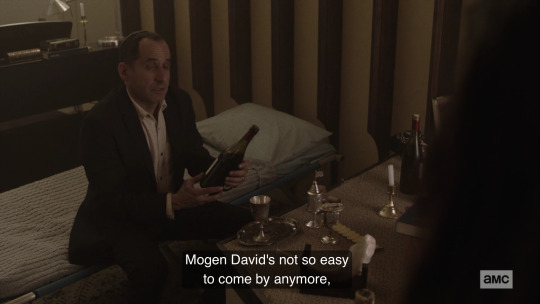
Back in the synagogue, we also find out the rabbi makes his own wine. He says he has a “green thumb.” Of course, the wine he makes is probably much different than moonshine, but the concept is the same. He's making his own booze.
While John and June are there, the rest of the rabbi’s congregation break out of the building through the glass (Breaking Glass Theory) and the synagogue is suddenly surrounded by walkers.

Then we have some ladders! After posting my ladder theory this last week, I was excited to see this. They were trying to find a way down to go help the convoy because Logan's people had found them and they were on the run. John uses a ladder and slams it into a car windshield, breaking it. He and June descend and use the ladder as a bridge between cars to try to get across the lot without actually having to walk among the walkers or kill them. Think about that. They’re using LADDERS as BRIDGES across CARS to get through a WALKER HORDE.
They nearly make it, but in the final leg of their journey, one of the fences falls — not unlike the church falling in 6x07 and letting walkers into Alexandria, and they know they can’t make it out.
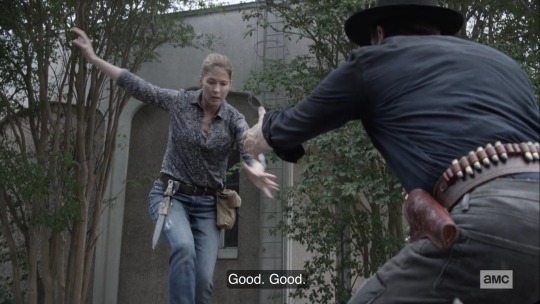
Charlie had one of Beth's lines here. Yet another way to show that she's a Beth proxy. When the rabbi tells her that it's okay, she says, "It's not okay, it's not okay." Beth said that twice a Grady as well. In fact, it was one of the last things she said before being shot, in reference to Noah staying behind.
John also used the phrase “exhibit A." He’s talking about how she wasn’t necessarily wrong to do what she did. She kept them all moving to avoid exactly the situation they were in: surrounded by walkers and trapped on top of a car. He says their “current circumstances are exhibit A.” So this is the A theory. I have more to say about this, but just keep it in mind for today.
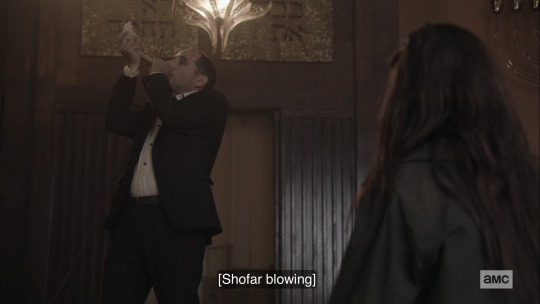
In order to save John and June, who were then trapped into the car, and get all them out of there, the rabbi blew a horn—a Jewish horn called a shofar—to lure the walkers into the church.
A couple of things about this. 1) The home is not unlike the wolf horn blown in 6x02, which also led the walker horde toward it, and led to Glenn’s death fake out sequence. 2) What follows in this episode is exactly what happened with Father Gabriel’s church in Coda. They lure the walkers into the synagogue and then trap them inside by barring the front doors.

It works, but the church/synagogue are lost. And once again, the last time we saw this was in CODA.
By the way, a shofar is made from the horn of a ram. We saw a ram one very prominent time before: in 5b when Aaron and Daryl were trying to capture buttons, Aaron tripped over one and nearly got bitten by a walker. So it’s a symbol they’ve used before.
In the end, the battery dies, the light goes out, and the Rabbi goes with them.
Meanwhile, Logan’s men chase Sarah and Dwight and the convoy for quite a while. Once they have them cornered (Sarah’s truck runs out of gas) they just drive away. It seems, at first, because Logan’s guys saw John and June in Al’s SWAT truck coming to the rescue, but Dwight still thinks it’s weird. He says these guys don’t do anything unless it’s on purpose. (Clue about the symbols in the show perhaps?)

Turns out, Dwight’s a smart dude when he wants to be. Somehow, probably from watching the Al’s tapes that he took from the vault last episode, he’s figured out where the oil fields are. He purposely had his guys chase Dwight’s group away so he could go steal the oil without them trying to stop him. The episode ends with him arriving at a place called Lonesome Quarry, where apparently the oil is.

That’s super interesting to me. I need to think on this some more and maybe I’ll address it again later on, but it’s interesting that it’s a quarry. That actually gave me a bit of a lightbulb moment. I started thinking about the quart from 6a. The group started Operation Lead the Walkers Away from there in 6x01 and it led to Glenn’s death fake out in 6x03. If you recall, there were even semis and tanker trucks in that quarry. The operation started a day early because on of them fell off a ledge, which allowed the walkers a way out of the quarry, so they had to start the operation earlier than expected.
So I’m wondering if that was a foreshadow to this, or if they’re at least purposely paralleling the two. Remember there was a death fake out involved in that. Both the beginning of a death fake out, and the end where Glenn was revealed to be alive. So I’m very curious to see where this will go.
Looking at the trailer for next week’s episode, where Logan will obviously make a play for the oil, there are things that look a LOT like 6a. Like this.
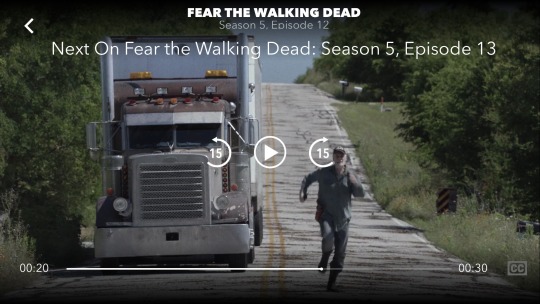
It’s Logan, probably running from Sarah in her truck. But it just LOOKS a lot like Rich running during 6a.
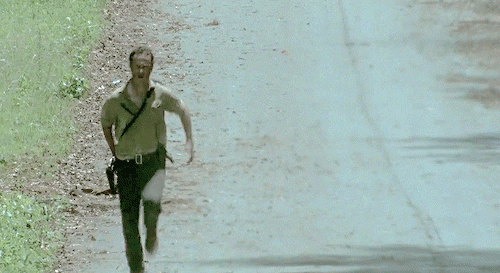
And then we see people approaching on horseback.
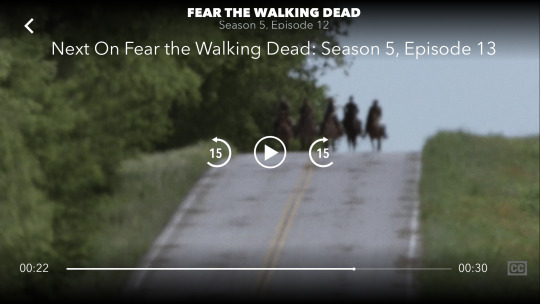
No idea who they are as the picture is intentionally blurry in the trailer, but probably new characters. Helicopter people? Highwaymen? Also reminds me of the horse from the TWD S10 trailer.
So again, no idea who it is, but I’m excited to find out.
So what are my major takeaways from this episode? We saw a lot of callbacks to the prison and to Father Gabriel’s story line in particular. Those are things that were happening in S4/S5 around Beth. Another religious dude with a crisis of faith. Losing his synagogue, like losing FG’s church, along with the alter, were both specifically seen in Coda.
Then there’s the eternal light and it’s ties to Beth, and the fact that the rabbi keeps referring to it and/or God as “she.” And finally, something big will probably go down over this fight for the oil. So a good episode. Leaves us with lots of questions, but I enjoyed it.
I’ll stop there for today. I have a lot more to say. Not about the episode specifically (a few things about it, though) but a lot of what I saw here symbolically made me start thinking or rethinking some of our theories. I suppose I just have some musings about where this may be going and how things might connect. So, pretty much predictions post. I’ll post more thoughts throughout the coming week. How did everyone else like this episode?
#beth greene#beth greene lives#beth is alive#beth is coming#td theory#td theories#team delusional#team defiance#beth is almost here#bethyl
1 note
·
View note
Text
Oct. 25 (UPI) -- The man who sold a gun to a British national who used it to hold four people hostage at a Texas synagogue in January was sentenced to nearly eight years' imprisonment, federal prosecutors said.
Chief U.S. District Judge David Godbey of the Northern District of Texas sentenced 33-year-old Henry "Michael" Dwight Williams to 95 months on Monday after he pleaded guilty in June to being a felon in possession of a firearm, the Justice Department said in a statement.
Prosecutors indicted Williams early this year, accusing him of selling Malik Faisal Akram a semiautomatic pistol two days before he used it to take four people hostage on Jan. 15 at Congregation Beth Israel, a synagogue in Colleyville, which is located within the Dallas-Fort Worth metroplex.
Akram was killed by law enforcement following a 11-hour standoff with police.
RELATEDMexican gunmen sentenced to life for killing U.S. consulate employee, 2 others
None of the hostages were harmed during the standoff, with one being released by Akram and the other three being rescued by police.
The pistol was retrieved from the scene by agents, and the FBI determined that Williams had sold it to Akram after reviewing the slain hostage-taker's phone records, which showed that the two had repeated phone calls days earlier.
Police arrested Williams on Jan. 24 on an outstanding state warrant, and when presented with a picture of Akram he confessed to having sold him a handgun on Jan. 13 at a South Dallas intersection.
RELATEDGarland announces arrest of Chinese spies who stole confidential information
"This defendant, a convicted felon, had no business carrying -- much less buying and selling -- firearms," U.S. Attorney Chad Meacham said in a statement. "Whether he suspected his buyer would use the gun to menace a community of faith is legally irrelevant: In the U.S., convicted felons cannot possess firearms."
Williams was previously convicted for aggravated assault with a deadly weapon and attempted possession of a controlled substance.
5 notes
·
View notes
Text
New Collections, 2019-05-07
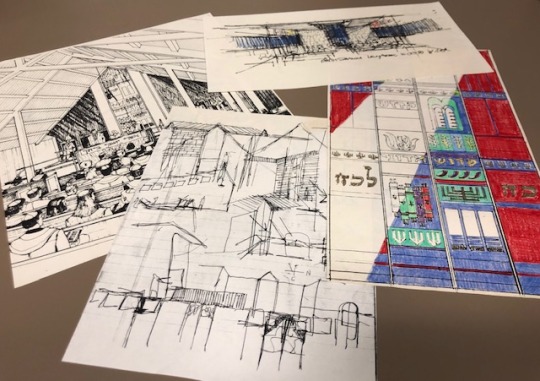
Morton and Jean Levy papers, MS 845
The collection consists of one box containing a scrapbook of, primarily, Morton Levy's architectural drawings of the proposed renovation to Congregation Brith Shalom's interior, correspondence, news clippings, and photographs of the congregation's interior from 1986-1996. In addition to the drawings in the scrapbook there are ten prints from Levy's portfolio (1997) of a number of synagogues that he worked on. The rest of the material -- two Congregation Beth Israel bulletins, news clippings, and two group photographs of Barnston B.B.G. members -- is from 1948 to 1954.
Morton Levy, a native Houstonian, graduated from high school in 1951. He received his Bachelor of Arts degree from Rice Institute in 1955 and his Bachelor of Science in Architecture, with distinction, from Rice in 1956. He founded his own architectural practice in 1963 and was licensed to practice architecture in Texas from 1960 through 2014. The resume for his award-winning practice includes service as architectural consultant to the U.S. Postal Service for thirteen years, eighteen projects for the City of Houston Department of Health and Human Services, four projects for the Houston Independent School District, seven Houston area synagogues, and eight renovation/expansion projects for the Houston Jewish Community Center. He retired in 2015.
Jean Merle Kanowitz Levy is a native of Pittsburgh, Pennsylvania, but moved with her family to Houston at the age of nine. A graduate of San Jacinto High School in Houston, Jean went on to receive a degree in Liberal Arts Studies from the University of Houston. Morton and Jean married in 1960 and have three children: Nanette (1961), Jay (1965), and Lisa (1966).
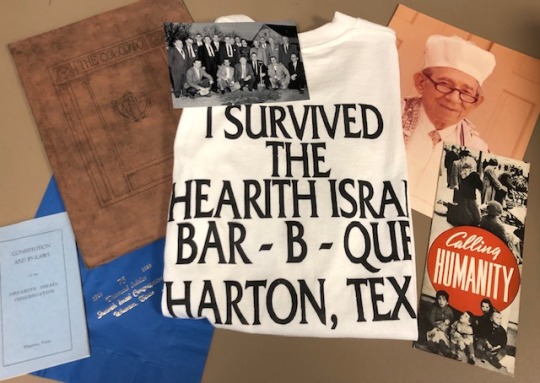
Shearith Israel Congregation collection, MS 738
The collection contains six boxes of correspondence, event materials (including programs, correspondence, and memorabilia), newsletters, bulletins, news clippings, books, photographs, financial documents, sermons, and video and audio material of events that document the history of Shearith Israel Congregation in Wharton, Texas, from 1921 to 2002.
Shearith Israel Congregation had its inception in 1899 when the Jewish citizens of Wharton, Texas, first met to conduct religious services, using members' homes as meeting places. As the community grew and the number of Jewish families increased plans were formulated for the building of a Synagogue. At first the membership consisted mainly of Wharton citizens, but as the Jewish population increased in surrounding towns the congregation expanded to include those who lived nearby from El Campo, Bay City, Ganado, Edna, Palacios, and Richmond. A tract of 2.14 acres was purchased and the building was completed in the fall of 1940. In 1956, the community dedicated a new, state-of-the-art synagogue building in the shape of a six-pointed Star of David at 1821 Old Lane City Rd., designed by Houston Jewish architect, Lenard Gabert. Perhaps, the most notable and enduring feature of the property, however, was the barbecue pit. Shearith Israel’s annual barbecue fundraiser, the social event of the year for the community, attracted hundreds of Jews and non-Jews from the area, as well as relatives and former members, who descended upon Wharton to eat chicken and cole slaw. The synagogue closed its doors in 2002, when membership dwindled from a peak of 400 members down to just 39, and sold its facilities. In 2010, the main building burned to the ground, and, besides the community hall that still stands, visitors to the site today will see nothing but a concrete slab where the sanctuary and school once stood.
Herman and Margarett Root Brown Family papers, MS 697
The collection consists of a range of keepsakes memorializing the lives of Herman and Margaret Root Brown and their family. The oldest in time are the high school senior class yearbook of Herman Brown and a framed loan document bearing his signature. There are many photographs, both formal portraits and small snapshots as well as intermediate size pictures. Among the people featured in addition to Herman, Margaret, and their children are the mother and sisters of Herman and George Brown, the wife and daughters of George, and some business associates.
Herman Brown, born in Belton, Texas in 1892, and Margaret Root, born in 1895, were married in 1917. Having begun doing construction work in Belton in 1914 and being paid in used equipment and mules, Herman formed a business which his brother-in-law Dan Root joined in 1919. They were in turn joined by Herman’s younger brother George in 1922. For the first twenty years their work was primarily road paving and bridge building throughout Texas. In 1942, with federal government involvement through freshman congressman Lyndon Baines Johnson, they completed a 1.3-mile-long dam near Austin.
World War II prompted the company’s expansion into ship-building, and it produced 359 destroyer escorts and other ship types. After the war Brown and Root expanded by acquiring (for $143 million) the U.S. government’s Big Inch and Little Big Inch pipelines (originally built to replace tanker ships vulnerable to German submarines).
In 1951 Herman and George Brown and their wives set up the Brown Foundation, which has made large gifts beginning with Rice University, Southwestern University (Margaret Root Brown’s alma mater), and the Museum of Fine Arts, Houston.
Two children joined the family of Herman and Margaret Brown, who had no children of their own. Louisa and Michael Stude were adopted and raised by the Browns but kept their birth names because their natural parents were still living.
Herman Brown died on November 15, 1962, and Margaret followed in 1963. To honor the memory of Margaret, George Brown and his wife Alice donated funds used to establish a residential college at Rice University. Margaret Root Brown College was dedicated October 3, 1965.
#congregation brith shalom#houston jewish history#houston jewish history archive#jean levy#lenard gabert#morton levy#shearith israel congregation#wharton#herman brown#margaret root brown#george brown#lyndon baines johnson#lbj#brown and root#special collections#rice university
3 notes
·
View notes